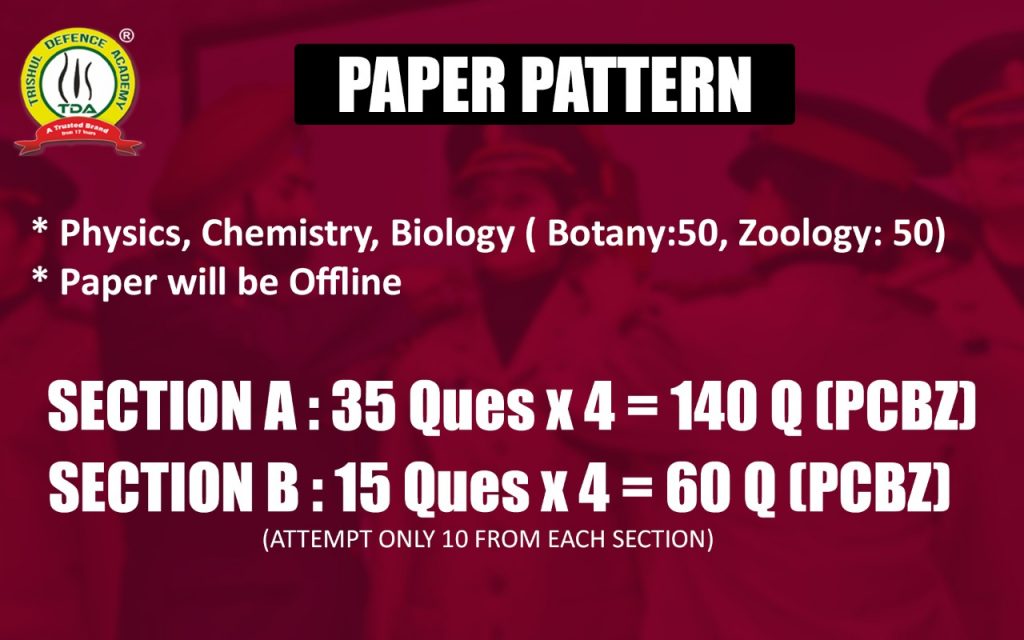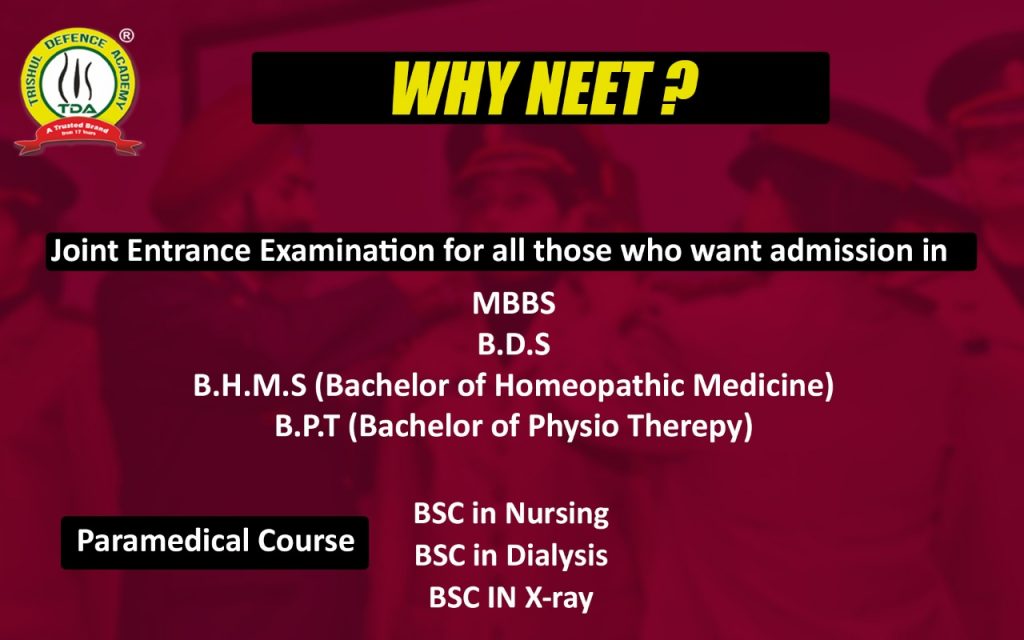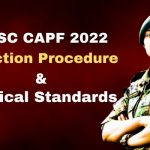MNS Through NEET Exam Syllabus & Exam Pattern
The National Eligibility-cum-Entrance Test (NEET)
NEET (UG) is being conducted by the National Testing Agency (NTA) since 2019 with the
approval of the Ministry of Health and Family Welfare and the Ministry of Human
Resource Development (which is now known as the Ministry of Education), for admission
to the undergraduate medical education in all medical institutions, including those governed
under any other law in force
Indian Army MNS Through NEET Exam Syllabus & Exam Pattern
The Entrance Test shall consist of 200 multiple choice questions (four options with a single
correct answer) from Physics, Chemistry and Biology (Botany & Zoology). 50 questions in
each subject will be divided into two sections (A and B) as per the details given below:
Section A shall consist of 35 (Thirty-five) Questions in each subject (Question Nos. – 1 to
35, 51 to 85, 101 to 135 and 151 to 185). All questions are compulsory.
Section B shall consist of 15 (Fifteen) Questions in each subject (Question Nos. – 36 to 50,
86 to 100, 136 to 150 and 186 to 200). In Section B, a candidate needs to attempt any 10
(Ten) questions out of 15 (Fifteen) in each subject.
There will be Negative Marking for both Sections i.e., Section A and Section B.
The candidate is required to attempt only 180 out of 200 MCQs.

The cutoff must be lower to MBBS.
Candidates are advised to read all 15 questions in each subject of Section B before they
start attempting the question paper. In the event of a candidate attempting more than ten
questions, the first ten questions answered by the candidate shall be evaluated.
Medium of Question Paper:
Candidates opting for English would be provided Test Booklet in English only.
Candidates opting for Hindi/Regional Language would be provided a Bilingual Test
Booklet i.e. in Hindi/Regional Language and English. In case of any ambiguity in the
translation of any of the questions, its English version shall be treated as final. Syllabus
MNS Through NEET Exam Syllabus
BIOLOGY syllabus topic wise
Zoology
- Animal Kingdom
- Structural Organisation in Animals
- Biomolecules
- Digestion and Absorption
- Breathing and Exchange of Gases
- Body Fluids and Circulation
- Excretory Products and their Elimination
- Locomotion and Movement
- Neural Control and Coordination
- Chemical Coordination and Integration
- Human Reproduction
- Reproductive Health
- Evolution
- Human Health and Disease
- Biotechnology Principles and Processes
- Biotechnology and its Applications
Botany
- Microbes in Human Welfare
- Organisms and Populations
- Ecosystem
- Biodiversity and Conservation
- Environmental Issues
- The Living World
- Biological Classification
- Plant Kingdom
- Morphology of Flowering Plants
- Anatomy of Flowering Plants
- Cell – The Unit of Life
- Cell Cycle and Cell Division
- Transport in Plants
- Mineral Nutrition
- Photosynthesis in Higher Plants
- Respiration in Plants
- Plant Growth and Development
- Reproduction in Organisms
- Sexual Reproduction in Flowering Plants
- Principles of Inheritance and Variation
- Molecular Basis of Inheritance
- Strategies for Enhancement in Food Production
Physics
- Units and Measurement
- Motion in A Straight Line
- Motion in A Plane
- Laws of Motion
- Work, Energy, and Power
- Systems of Particles and Rotational Motion
- Gravitation
- Mechanical Properties of Solids
- Mechanical Properties of Fluids
- Thermal Properties of Matter
- Thermodynamics
- Kinetic Theory of Gases
- Oscillations
- Waves
- Mathematical Tools
-
Electric Charges and Fields
- Electrostatic Potential and Capacitance
- Current Electricity
- Moving Charges and Magnetism
- Magnetism and Matter
- Electromagnetic Induction
- Alternating Current
- Electromagnetic Waves
- Ray Optics and Optical Instruments
- Wave Optics.
- Dual Nature of Radiation and Matter
- Atoms
- Nuclei
- Semiconductor Electronics
Chemistry
- Some Basic Concepts Of Chemistry
- Structure of Atom
- Classification of Elements and Periodicity
- Chemical Bonding and Molecular Structure
- The States of Matter
- Thermodynamics
- Equilibrium
- Redox Reactions
- Hydrogen
- The s-Block Elements
- The p-Block Elements (XI)
- Organic Chemistry – Some Basic Principles And
Techniques - Hydrocarbons
- Environmental Chemistry
- The Solid State
- Solutions
Electrochemistry
Elements

Science point by point Prospectus
Unit 1 – Variety in Living World
Biodiversity; Need for characterization; Three areas of life; Scientific categorization and Systematics; Idea of species and ordered order; Binomial terminology; Instruments for investigation of Scientific categorization Herbaria, Professional flowerbeds; Five realm characterization; Striking highlights and arrangement of plants; Notable elements and characterization of creatures
Unit 2 – Underlying Association in Creatures and Plants
Morphology and alterations; Tissues; Life systems and elements of various pieces of blooming plants; Creature tissues;
Morphology, life structures, and elements of various frameworks
Unit 3 – Cell Design and Capacity
Cell hypothesis and cell as the essential unit of life; Design of prokaryotic and eukaryotic cell; Plant cell and creature cell; Substance constituents of living cells: Biomolecules; Cell division
Unit 4 – Plant Physiology
Transport in plants; Significant distance transport of water; Happening Opening and shutting of stomata; Take-up and movement of mineral supplements; Dissemination of gases Mineral sustenance; Inadequacy side effects; Mineral poisonousness; Rudimentary thought of Aquaculture; Nitrogen digestion Nitrogen cycle, natural nitrogen obsession Photosynthesis; Site of photosynthesis occur; Photochemical and biosynthetic periods of photosynthesis; Cyclic and non-cyclic and photophosphorylation; Chemiosmotic theory; Photorespiration C3 and C4 pathways; Elements influencing photosynthesis Breath; Cell breath; Energy relations-Number of ATP particles created; Amphibolic pathways; Respiratory remainder Plant development and improvement; Separation, dedifferentiation and Redifferentiation; Grouping of formative process in a plant cell; Development Controllers; Vernalisation; Photoperiodism
Unit 5 – Human Physiology
Assimilation and ingestion; Egestion; Nourishing and stomach related messes Breathing and Breath; Respiratory framework in people; Component of breathing and its guideline in people; Problems connected with breath Asthma, Emphysema, Word related respiratory issues Body liquids and flow; Human circulatory framework; Guideline of cardiovascular movement; Problems of circulatory framework Hypertension, Coronary supply route illness, Angina pectoris, Cardiovascular breakdown Excretory items and their end; Human excretory framework; Pee development, Osmoregulation; Guideline of kidney work Renin-angiotensin, Atrial Natriuretic Variable, ADH and Diabetes insipidus; Problems; Uraemia, Renal disappointment, renal calculi, Nephritis; Dialysis and counterfeit kidney
Headway and Development; Skeletal framework and its capacities; Joints; Problems of solid and skeletal framework Myasthenia Gravis, Tetany, Strong dystrophy, Joint inflammation, Osteoporosis, Gout
A Tactical Point ………
Brain control and coordination; Sensory system in people focal sensory system, fringe sensory system and instinctive sensory system Age and conduction of nerve drive; Reflex activity; Receptors; Rudimentary design and capacity of eye and ear Compound coordination and guideline; Human endocrine framework Nerve center, Pituitary, Pineal, Thyroid, Parathyroid, Adrenal, Pancreas, Balls; Instrument of chemical activity; Job of chemicals as couriers and controllers; Hypo-and hyperactivity and related messes Class twelfth section-wise NEET Science prospectus.
Unit 1 – Multiplication
Proliferation in creatures; Abiogenetic propagation; Modes Sexual proliferation in blooming plants: Blossom structure; Advancement of male and female gametophytes; Fertilization types, organizations, and models; Outbreeding gadgets; Dust Pistil cooperation; Twofold preparation; Post-treatment occasions Improvement of endosperm and undeveloped organism, Advancement of seed and development of the natural product; Unique modes-apomixis,
parthenocarpy, polyembryony; Meaning of seed and organic product arrangement Human Propagation; Infinitesimal life structures of testis
furthermore, ovary; Gametogenesis-spermatogenesis and oogenesis; Feminine cycle; Preparation, incipient organism advancement up to blastocyst arrangement, implantation; Pregnancy and placenta development; Parturition; Lactation
Conceptive wellbeing: Need for regenerative well-being and anticipation of physically sent infections (sexually transmitted disease); Anti-conception medication
Need and Techniques, Contraception and Clinical End of Pregnancy (MTP); Amniocentesis; Fruitlessness and helped conceptive advances — IVF, ZIFT, GIFT
Unit 2 – Hereditary qualities and Advancement
Heredity and variety: Mendelian Legacy; Chromosome hypothesis of legacy; Chromosomes and qualities; Sex
assurance In people, birds, bumble bee; Linkage and getting over; Sex-connected legacy Hemophilia, Variety
visual impairment; Mendelian problems in people Thalassemia; Chromosomal issues in people; Down’s condition, Turner’s furthermore, Klinefelter’s disorders Sub-atomic premise of Legacy: Quest for hereditary material and DNA as hereditary material; Construction of DNA and RNA; DNA bundling; DNA replication; Focal authoritative opinion; Record, hereditary code, interpretation; Quality articulation and guideline Lac Operon; Genome and human genome project; DNA fingerprinting Development: Beginning of life; Organic advancement and confirmations for natural advancement from Fossil science, relative life systems, embryology and atomic proof); Darwin’s commitment, Current Engineered Hypothesis of Advancement; Component of development; Quality stream and hereditary float; Tough Weinberg’s standard; Versatile Radiation; Human advancement
Unit 3 – Science and Human Government assistance
Wellbeing and Sickness; Essential ideas of immunology-antibodies; Disease, HIV and Helps; Pre-adulthood, medication and liquor misuse Improvement in food creation; Plant reproducing, tissue culture, single cell protein, Bio stronghold; Apiculture and Creature farming Microorganisms in human government assistance: In family food handling, modern creation, sewage treatment, energy age and as biocontrol specialists and bio composts
Unit 4 – Biotechnology and Its Applications Standards and interaction of Biotechnology:
Hereditary designing, Use of Biotechnology in wellbeing and agribusiness: Human insulin and antibody creation, quality treatment; Hereditarily altered life forms Bt crops; Transgenic Creatures; Biosafety issues-Bio robbery and licenses
Unit 5 – Biology and climate Living beings and climate;
Populace associations mutualism, rivalry, predation, parasitism; Populace ascribes development, rate of birth and demise rate, age dissemination Environment; Energy stream
A Tactical Point ………
Pyramids of number, biomass, energy; Supplement cycling; Natural progression; Environmental Administrations Carbon obsession, fertilization, oxygen discharge Biodiversity and its preservation; Examples of Biodiversity; Significance of Biodiversity; Loss of Biodiversity; Biodiversity preservation; Areas of interest, imperiled creatures, annihilation, Red Information Book, biosphere holds, Public parks and asylums Ecological issues: Air contamination and its control; Water contamination and its control; Agrochemicals and their belongings; Strong squander the board; Radioactive waste administration; Nursery impact and an unnatural weather change; Ozone consumption; Deforestation Material science.
Unit 1 – Electrostatics
Electric charges and their protection. Coulomb’s regulation power between two point charges, electric
field, electric field because of a point charge, electric field lines, electric transition, proclamation of Gauss’
hypothesis, electric potential, possible contrast, conveyors and protectors, dielectrics and electric
polarization, capacitors and capacitance, Van de Graff generator
Unit 2 – Flow power
Electric flow, Ohm’s regulation, electrical opposition, V-I qualities, carbon resistors, variety code for
carbon resistors, inside obstruction of a cell, Kirchhoff’s regulations, Wheatstone span, meter span.
potentiometer
Unit 3 – Attractive impacts of current and attraction
Idea of attractive field, Oersted’s analysis. Biot-Savart regulation, Ampere’s regulation, cyclotron, force on
a current-conveying guide in a uniform attractive field. Force between two equal current-conveying
guides, force experienced by an ongoing circle in an attractive field; moving curl galvanometer
Current circle, attractive field force, force on an attractive dipole, bar magnet as a same solenoid, attractive field lines; Earth’s attractive field. Para-, dia-and ferro-attractive substances Electromagnetic and factors influencing their assets. Long-lasting magnets
Unit 4 – Electromagnetic acceptance and exchanging current
Electromagnetic acceptance; rotating flows, AC generator and transformer
Unit 5 – Electromagnetic waves
Need for relocation current, electromagnetic waves, electromagnetic range
Unit 6 – Optics
Impression of light, round mirrors, reflect recipe. Refraction of light, complete interior reflection,
amplification, force of a focal point, refraction and scattering of light through a crystal, dispersing of light,
optical instruments, magnifying lens and galactic telescopes (reflecting and refracting) and their
amplifying powers., wave optics, evidence of laws of reflection and refraction utilizing Huygens standard,
impedance, diffraction because of a solitary cut, settling force of magnifying instruments and galactic
telescopes. Polarization, plane captivated light; Brewster’s regulation
Unit 7 – Double nature of issue and radiation
Photoelectric impact, Hertz and Lenard’s perceptions; Einstein’s photoelectric condition – molecule
nature of light, matter waves
A Tactical Point ………
Unit 8 – Iotas and cores
Alpha particles, levels, hydrogen range, organization and size of core, nuclear masses, isotopes,
isobars; isotones, radioactivity, mass-energy connection, mass deformity
Unit 9 – Electronic gadgets
Energy groups in solids, I-V qualities, Zener diode as a voltage controller. Intersection semiconductor,
semiconductor activity, oscillator, rationale doors Science
Unit 10 – A few essential ideas of Science General
Unit 7 – Balance
Balance in Physical and substance processes, law of synthetic harmony, balance steady,
Le Chatelier’s guideline, ionic harmony, hydrolysis of salts, cushion arrangements, Henderson condition,
solvency item, normal particle impact
Unit 8 – Redox responses
Idea of oxidation and oxidation and decrease, redox responses oxidation number
Unit 9 – Hydrogen
Event, isotopes, readiness, properties and utilizations of hydrogen, hydrides-ionic, covalent and
interstitial, weighty water; hydrogen peroxide-readiness
A Tactical Point ………
Unit 10 – s-Square elements(Alkali and soluble earth metals)
Bunch 1 and gathering 2 components: Electronic arrangement, event, bizarre properties of the first
component of each gathering, arrangement and properties of a few significant mixtures Sodium carbonate,
sodium chloride, sodium hydroxide and sodium hydrogen carbonate, modern utilization of lime and
limestone, organic significance of Mg and Ca
Unit 11 – Some p-block components
General prologue to p-Square components Gathering 13 components: Electronic arrangement, event,
variety of properties, oxidation of states, patterns in synthetic reactivity, significant mixtures: borax,
boric acids, boron hydrides, aluminum General 14 components: Electronic setup, event,
variety of properties, oxidation of states, patterns in synthetic reactivity, irregular way of behaving of first
component, carbon Significant mixtures of silicon
Unit 12 – Natural Science A few Essential Standards and Procedures
Strategies for filtration subjective and quantitative examination, arrangement and IUPAC terminology
of natural mixtures, electronic relocations in a covalent bond, homolytic and heterolytic splitting
of a covalent bond
Unit 13 – Hydrocarbons
Alkanes, alkenes, alkynes, fragrant hydrocarbons
Unit 14 – Natural Science
Ecological contamination – Air, water and soil contamination
Class twelfth part wise NEET Science schedule
Unit 1 – Strong state
Grouping of solids in view of various restricting powers; band hypothesis of metals, directors,
semiconductors and covers
Unit 2 – Arrangements
Kinds of arrangements, articulation of grouping of arrangements of solids in fluids, the dissolvability of gases
in fluids, strong arrangements, colligative properties
Unit 3 – Electrochemistry
Redox responses, conductance in electrolytic arrangements, explicit and molar conductivity variety of
conductivity with fixation, lead aggregator, EMF of a cell, standard cathode potential,
connection between Gibbs energy change and EMF of a cell, power devices; consumption
Unit 4 – Compound Energy
Pace of a reaction(average and prompt), factors influencing paces of response; fixation,
temperature, impetus; request and molecularity of a response; rate regulation and explicit rate steady,
enactment energy, Arrhenius condition
Unit 5 – Surface Science
Adsorption, differentiation between evident arrangements, colloids and suspensions; lyophilic, lyophobic
multimolecular and macromolecular colloids; properties of colloids; Tyndall impact, Brownian
development, electrophoresis, coagulation; emulsions
Unit 6 – General standards and cycles of disconnection of components
Standards and strategies for extraction – focus, oxidation, decrease electrolytic techniques and
refining; event and standards of extraction of aluminum, copper, zinc and iron
A Tactical Point ………
Unit 7 – p-Square components
Bunch 15 components, Gathering 16 components, Gathering 17 components, Gathering 18 components
Unit 8 – d and f Square components
General presentation, electronic design, qualities of progress metals, general patterns in
properties of the main line change metals, arrangement and properties of K2Cr2O7 and KMnO4,
lanthanide, actinides
Unit 9 – Coordination Mixtures
Coordination compounds – Presentation, ligands, coordination number, variety, attractive properties
also, shapes, IUPAC classification of mononuclear coordination compounds, isomerism (underlying and
sound system) holding, Werner’s hypothesis VBT,CFT; significance of coordination compounds
Unit 10 – Haloalkanes and Haloarenes
Haloalkanes, haloarenes, dichloromethane, trichloromethane, tetrachloromethane, iodoform, freons,
DDT – Classification, strategies for planning, physical and compound properties
Unit 11 – Alcohols, Phenols and Ethers
Alcohols – Classification, techniques for readiness, physical and substance properties (of essential
alcohols just); recognizable proof of essential, optional and tertiary alcohols, instrument of lack of hydration,
utilizes with exceptional reference to methanol and ethanol, phenol, ethers
Unit 12 – Aldehydes, ketones and carboxylic acids
Aldehydes and ketones, carboxylic acids – Terminology, techniques for planning, physical and
compound properties
Unit 13 – Natural mixtures containing Nitrogen
Amines – terminology, order, structure, strategies for planning, physical and compound
properties, utilizes, recognizable proof of essential auxiliary and tertiary amines, cyanides and isocyanides,
diazonium salts
Unit 14 – Biomolecules
Sugars – Characterization (aldoses and ketoses), monosaccharide (glucose and fructose), D.L.
setup, oligosaccharides (sucrose, lactose, maltose), polysaccharides (starch, cellulose,
glycogen): significance, proteins, chemicals, nutrients, nucleic acids – DNA and RNA
Unit 15 – Polymers
Grouping – normal and engineered, techniques for polymerization (expansion and buildup),
copolymerization. A few significant polymers: regular and manufactured like polyesters, Bakelite; elastic,
biodegradable and non-biodegradable polymers
Unit 16 – Science in Daily existence
Synthetic substances in medications, synthetic substances in food – additives, counterfeit improving specialists, rudimentary thought of cell reinforcements, purifying specialists
Trishul Protection Institute attempted and provided you with an extensive of MNS prospectus
for which endeavors have been greatest in giving the total subtleties of MNS prospectus to make your readiness more straightforward and more brilliant.
Popular Post MNS 2022 Through NEET:- Click Here
Connect with Trishul Defence Academy for the latest updates, and notifications.
JOIN TRISHUL DEFENCE ACADEMY TODAY FOR SSB In 2022
Do you wish to prepare for SSB Interview? If Yes, Then Trishul Defence Academy is your study point!
Under the guidance of SSB Master Colonel Pankaj Mehrotra (Ex-NDA, Ex- IO) 11 34 SSB, Allahabad & 21 22 SSB Bhopal, prepare for each and every test of SSB with full expertise. Ranging from written, psychological or group tasks, with TDA you are determined for success.
Trishul Defence Academy, the best defence coaching institution in Northern India will help you make your dreams come true. Enrol yourself today to prepare for Air Force Entrance Exams 2021- SSB Interview, AFCAT, AIR FORCE X AND Y GROUP, NDA, CDS.
With the inspiration of Trishul’s founder, Late Wing Commander Anoop Mehrotra Sir, we proudly announce admissions for the SSB interview preparation course for the academic session of 2022. Come join us today for the ultimate success in SS
Our dedicated and experienced faculty will provide the determined candidates with full overhaul training ranging from online classes, personality development sessions, crash courses, physical training, mock tests, and much more.
Call and connect with us to book a seat for yourself for the upcoming batch of 2022. Special discount offer on booking at the earliest. For any query/inquiry, you can connect us via the following ways: –
Official Website – https://trishuldefenceacademy.in/
Website – https://trishuldefenceacademy.com/
Facebook – https://www.facebook.com/trishuldefenceacademy
Twitter – https://twitter.com/trishuldefence
Address- Gayatri Dham, Millan Tower Behind Max Mall, Civil Lines, Allahabad, Uttar Pradesh 211001
Mobile No- 8400083030
Wish you all the success.
Jai hind





